Aide-de-camp
This articleneeds additional citations forverification.(August 2007) |
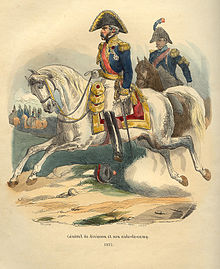
Anaide-de-camp(UK:/ˌeɪddəˈkɒ̃/,US:/-ˈkæmp/;[1]Frenchexpression meaning literally "helper in the[military] camp"[2]) is apersonal assistantorsecretaryto a person of highrank,usually a seniormilitary,policeorgovernment officer,or to a member of aroyal familyor ahead of state.
An aide-de-camp may participate atceremonialfunctions, and the first aide-de-camp is typically the foremost personal aide. This is not to be confused with anadjutant,who is the senior administrator of a military unit.
The badge of office for an aide-de-camp is usually theaiguillette,a braided cord in gold or other colours, worn on the shoulder of a uniform. Whether it is worn on the left or the right shoulder is dictated by protocol.
In some countries, aide-de-camp is considered to be atitle of honour,which confers thepost-nominal lettersADC, A.D.C.[2]or A de C.
Argentina
[edit]This sectionneeds additional citations forverification.(October 2022) |
InArgentina,three officers, one from each armed service, of the rank of lieutenant colonel or its equivalent, are appointed as aide-de-camp to thepresident of the republicand three others to theminister of defense,these six being the only ones to be callededecán,which is one Spanish translation for aide-de-camp (edecánis a phonetic rendition of the French term;ayudaorayudante de campois acalque).
A controversy was raised in 2006, when presidentNéstor Kirchnerpromoted his army aide-de-camp, Lieutenant Colonel Graham, to colonel, one year ahead of his class. Upon becoming president,Cristina Kirchnerdecided to have, for the first time, female officers as her aides-de-camp.
In each of the armed forces, the chief of staff and other senior officers have their own adjutants, normally of the rank of major or lieutenant colonel, or its equivalent. At unit level, the unitS1(personnel officer) doubles as the unit commander's adjutant, although in recent times in many units this practice has been left only for ceremonial purposes, while for everyday duties a seniornon-commissioned officerperforms the adjutant's activities.
An aiguillette is worn on the right shoulder by aides-de-camp and adjutants as a symbol of their position, the colour of the aiguillette depending on the rank of the person they are serving (there are golden, tan, silver and red aiguillettes, as well as an olive-green one for combat uniform).
Belgium
[edit]InBelgium,the Head of the King's Military Household is a two, three or four-star General who helps the King exercise the powers vested in him by the constitution in the field of defence. He monitors the international security situation and informs the King accordingly. He keeps the King posted of the situation, means and resources, functioning and missions of the Belgian Armed Forces, in close cooperation with the King's Cabinet. The Head of the Military Household also oversees the coordination with the security detail of the Royal Palace and runs the Information Technology Service.
The Aides de Camp to the King are general or senior officers assigned by the King to accompany important visitors or to represent him on occasions when he cannot be present himself.
The Equerries to the King are at the King's constant disposal on a rotational basis; they accompany him on his travels and assist him in performing his daily tasks.[3]
The title of honorary aide-de-camp to thekingcan be granted by the royal court for services rendered. Notable people include Major General BaronÉdouard Empain,Count Charles John d'Oultremont, and Lieutenant General BaronAlbert du Roy de Blicquy.
Commonwealth of Nations countries
[edit]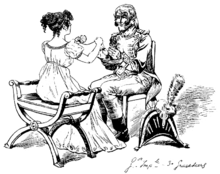
InCommonwealth of Nationscountries, aides-de-camp are mostly appointed from military or auxiliary services. They are entitled to use the letters ADC or A de C after their names.[4]The emblem of the office is theaiguilletteworn on their uniform.
Australia
[edit]This sectionneeds additional citations forverification.(October 2022) |
InAustralia,Australian Defence Force officers serve as aides-de-camp to specific senior appointments, such as themonarch,governor-general,state governors,chief of the Defence Force,and other specified Army, Navy and Air Force command appointments. Honorary aides-de-camp to the governor-general or state governors are entitled to the post-nominal ADC during their appointment.
Officers of and above the ranks of rear admiral, major general, and air vice-marshal in specifically designated command appointments are entitled to an aide-de-camp with the army rank of captain (or equivalent). Within the navy, an aide-de-camp is called a "flag lieutenant" and senior naval officers are called "flag officers".
Bermuda
[edit]This sectionneeds additional citations forverification.(October 2022) |
In 1973,Sir Richard Sharples,thengovernor of Bermuda,and his aide-de-camp, Captain Hugh Sayers, were murdered on the grounds of Government House.
Canada
[edit]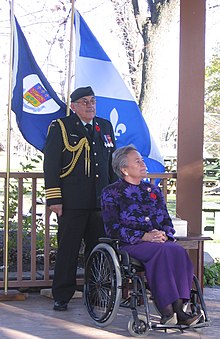

Aides-de-camp inCanadaare appointed to themonarchand some members of theroyal family,thegovernor general,lieutenant governors,and to certain other appointments (e.g.,Minister of National Defence,flagandgeneral officers,Canadian heads of mission, foreign heads of state visiting Canada).[5]
In addition to the military officers appointed as full-time aides-de-camp to the governor general, several other flag, general, and senior officers are appointedex officioas honorary aides-de-camp to the governor general or members of the royal family including:[5]
- Chief of the Defence Staff
- Commandant of theRoyal Military College of Canada
- A senior officer of the Quebec-basedRoyal 22eRégiment
- Commanding officer,the Governor General's Horse Guards
- Commanding officer,Governor General's Foot Guards
- Commanding officer,the Canadian Grenadier Guards
- Commanding officer,the Queen's Own Rifles of Canada
- Commanding officers ofNaval Reservedivisions
Most aides-de-camp wear a gold-patternaiguillettewhen acting in their official capacity; however, members ofSt. John Ambulance Canadawear silver aiguillettes consistent with their other accoutrements as aides-de-camp or as a symbol of ceremonial representation such as a member of the honour guard or a position of command on parade.[citation needed]All aides-de-camp also wear the cypher or badge of the principal to whom they are appointed.[6]Honorary appointees to the monarch, such as theroyal cypheror thePrince of Wales,wear the appropriate cypher on their uniform epaulette and are entitled to use the post-nominal letters ADC for the duration of their appointment.
Aides-de-camp to the governor general wear the governor general's badge, known as the crest of thearms of Canada,and aides-de-camp to a lieutenant governor wear the lieutenant governor's badge (the shield of the province surmounted by a crown).[6]They are appointed from officers of theCanadian Forces.Aides-de-camp to lieutenant governors are appointed from officers of the Canadian Forces,Royal Canadian Mounted Policeand, depending on the province, aides may also be appointed from other uniformed organizations such as municipal or provincial police and emergency services. In certain instances, civilians may be appointed. Non-uniformed civilians do not wear the aiguillette, but do wear their lieutenant governor's badge as a symbol of their appointment. On 29 November 1973, Governor GeneralRoland Michenerconcluded his initiative to permit aides-de-camp to the governor general and lieutenant governors to use the post-nominal letters A de C for the duration of their appointment.[4][7]
Aides-de-camp to royal and vice-regal personages wear the aiguillette on the right shoulder. Aides-de-camp to all others wear their aiguillette on the left shoulder.[6]
India
[edit]
InIndia,officers of the rank ofmajor generaland equivalent and above in the sister services who are in command of divisions or of peacetime commands have aides-de-camp who usually belong to their general's parent regiment/battalion. There have been instances where the sons have served a tenure of aide-de-camp to their fathers. In India, aide-de-camp is atitle of honour,and current as well as former aides-de-camp are conferred thepost-nominal lettersADC.
The service chiefs, including the chief of theArmy,Navy,andAirStaff, usually have three aides-de-camp and thepresident of Indiahas five aides-de-camp (three from the Army and one each from the Navy and the Air Force). There is also one honorary aide-de-camp from theTerritorial Army.The president may at his or her pleasure appoint any distinguished officer from the armed forces including the service chiefs as honorary aide-de-camp. Thegovernorsof the states have two aides-de-camp, one each from theIndian Armed Forcesand the Indian and state police services except for the state ofJammu and Kashmir,where both the aides-de-camp to the governor are appointed from theIndian Army.
Malaysia
[edit]An aide-de-camp oradikungas it known locally inMalaysiais appointed by thefederal governmentor thestate governmentfrom officers of theRoyal Malaysian Policeor from theMalaysian Armed Forcesofficers comprising theMalaysian Army,Royal Malaysian Air Forceor fromRoyal Malaysian Navy.There were also non-military or police officers who were appointed as aide-de-camp.
New Zealand
[edit]As in other Commonwealth countries where themonarchis head of state, personnel from theNew Zealand Defence Forceserve as aides-de-camp to royal and vice-regal personages. The governor-general of New Zealand has two full-time aides-de-camp of the rank ofarmycaptain,lieutenantRNZNorRNZAFflight lieutenant.Additional and honorary aides-de-camp to the governor-general are of the rank of lieutenant colonel or equivalent.Aiguilettesare of the standard palaceNo.1 type and worn on the right shoulder. Equivalent appointments also serve theminister of Defence,thechief of Defence Forceand service chiefs. These are usually known as military assistants (MA) personal staff officers (PSOs) or, in the case of the RNZN, flag lieutenant (flags), and wear service-specificNo.2 aiguillettes with coloured flecks (dark blue for navy, red for army and light blue for air force) on the left shoulder.
Pakistan
[edit]InPakistan,thepresident,prime minister,and governors have their own aides-de-camp. The aide-de-camp can be from any one of the threeArmed Forcesand typically are of the rank ofcaptain(army),lieutenant(navy) orflight lieutenant(air force). The aide-de-camp to JusticeKhan Habibullah Khan,while he was chief minister and leader of the house ofWest Pakistan,was his son, a senior bureaucrat, Captain Akhtar Munir Marwat and CaptainGohar Ayub Khanwas to his father, President Field MarshalAyub Khan.The chairman of the Joint Chiefs of Staff Committee and all the three service chiefs are authorised to have an aide-de-camp. In Pakistan, officers of the rank of major general and equivalent and above in the sister services who are in command of divisions or of peacetime commands have aides-de-camp who usually belong to their general's parent regiment/battalion.
Papua New Guinea
[edit]As in othercommonwealth realmswhere themonarchis head of state, the governor-general of Papua New Guinea has two full-time aides-de-camp. One is from thePapua New Guinea Defence Forceand one from theRoyal Papua New Guinea Constabularyof the ranks ofPNGDFcaptainandRPNGCsuperintendent.[8]
Singapore
[edit]InSingapore,thepresidentappoints aides-de-camp from theSingapore Armed Forces(SAF), theSingapore Police Force(SPF) and theSingapore Civil Defence Force(SCDF). Selected SAF officers typically hold the rank of major ormilitary expert 5,selected SCDF officers hold the rank of major, and selected SPF officers typically hold the rank of assistant superintendent of police. Both male and female officers may serve as aides-de-camp.
Their duties include assisting in liaison for important guests on behalf of the president and taking care of visiting foreign dignitaries.[9]
Sri Lanka
[edit]InSri Lanka,thepresidenthas an aide-de-camp and an extra aide-de-camp from the three armed services. Allgeneral,flagandair officersare entitled to an aide-de-camp, usually selected from their parent regiment or unit. In the navy, an aide-de-camp is called a flag lieutenant.Junior officers(of the rank of major and below) of the armed services who have completed three years of service can be appointed for (extra-regimental) special appointments as an aide-de-camp or extra aide-de-camp for a maximum of three years. Following such appointment, reappointment is not possible for two years. Medical officers of the rank oflieutenant coloneland above can be appointed as honorary physician to the president or honorary surgeon to the president.[10]
The tradition dates back to the office ofgovernor of Ceylon.The governor's staff included an aide-de-camp as a permanent appointment drawing pay from the civil list, usually held by a retired junior officer from a British Army regiment. In addition the governor's staff included thehead mudaliyarwho served as the native aide-de-camp to the governor on a permanent and honorary (non-paid) basis; as well as several extra aide-de-camp appointed from regiments of theCeylon Defense Forceand later from theCeylon Royal Naval Volunteer Reserve.With the formation of the office of theGovernor-General of Ceylonthe practice continued with Ceylon Army officers replacing the British Army officers. At present an officer of the rank of brigadier serves as aide-de-camp to the president, while an officer of the rank of colonel or equivalent serves as aide-de-camp to the defence secretary.[11]
In 1992, two Sri Lankan ADCs were killed in active service, and in 2006 an ADC was severely wounded:
- On 8 August 1992,Major GeneralDenzil Kobbekaduwa(Overall Operations Commander - Northern Sector) and his aide-de-camp Major Nalin S. De Alwis, were killed along with several senior army and navy officers when theirLand Roverhit a land mine off Araly Point inKayts.[12]
- On 16 November 1992, theCommander of the Sri Lanka Navy,Vice AdmiralClancy Fernandoand hisflag lieutenant,LieutenantSandun Gunasekera, were assassinated by aLTTEsuicide bomberwho drove an explosives laden motorbike into the admiral'sstaff carin front of theGalle Face Green.[13]
- In 2006, theCommander of the Sri Lanka Army,Lieutenant GeneralSarath Fonseka,and his aide-de-camp Major Priyal Wickramasinghe were severely wounded in a LTTE suicide bomb attack by a pregnant LTTE operative on the general's staff car insideArmy Headquarters.[14][15][16]
Tanzania
[edit]Thepresident of Tanzaniahas an aide-de-camp from theTanzania People's Defence Force,with the rank ofkanali,which is equivalent to that of acolonel.
United Kingdom
[edit]Historic usage
[edit]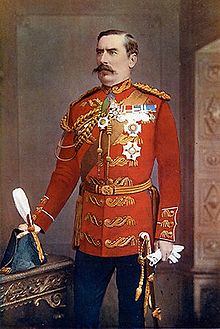
In theUnited Kingdom,an aide-de-camp (ADC) was defined in 1875 as "a confidential officer attached to the 'personal' or private staff of ageneral".[17]In thefield of battle,he functioned as "the bearer of his chief's written or verbal orders, and when employed as the general's mouthpiece must be implicitly obeyed".[17]In garrison or quarters, however, his duties were more of a social character: "he superintends the general's household, writes and answers invitations, &c."[17]Historically, the appointment pertained only to the Army (in the Navy aflag lieutenantperformed equivalent duties: "communicating the admiral's orders to the various ships either personally or by signal" ).[18]
According to a British military dictionary dating from 1816, an ADC usually held rank equal to, or more senior than, anarmy captain."Generals, beingfield marshalshave four [aides-de-camp],lieutenant generalstwo, [and]major generalsone ".[19]
The sovereign, ashead of the army,was entitled to appoint "an indefinite number of aides-de-camp".[17]Under Queen Victoria, appointments were made (from both the regular Army and theRoyal Marines) in recognition of distinguished war service; the appointment at that time carried with it promotion to the rank offull colonel.Additional honorary appointments were made from among the officers of theMilitia.Queen Victoriaalso appointed a number of "naval aides-de-camp" in "compliment to the sister service".[17]
Colonialgovernors,governors-generaland thelord lieutenant of Ireland[2]also appointed aides-de-camp, who had a functional role akin to that ofequerriesin theRoyal Householdin which aides-de-camp have a primarily honorific role.[17]
A distinctive and elaboratefull dress uniformused to be worn by army aides-de-camp; however, its use was largely discontinued afterWorld War I.
Present day
[edit]In theBritish Armyand theRAF,a junior officer may be appointed to serve as aide-de-camp to a senior officer; the equivalent appointment in theRoyal Navyis flag lieutenant. Certain of the monarch's representatives, includinglord-lieutenantsof counties, may appoint their own aides-de-camp.[20]
The Royal Household
[edit]In addition, a fixed number of senior officers may be appointed as aides-de-camp to the monarch, an appointment which entitles the holder to thepost-nominal letters"ADC". Most of these are serving army, navy, and air force officers, usually of colonel or brigadier rank or equivalent. They are seldom called upon individually to perform specific duties; collectively, they walked in procession at everycoronationandstate funeralof a monarch in the 20th century.[21]In 1991 the aides-de-camp to the queen numbered sixty:[22]
- Eight from the Royal Navy (captains and commodores)
- Three from theRoyal Naval Reserve
- One from the Royal Marines (a colonel)
- One from theRoyal Marines Reserve
- Eighteen from the Army (brigadiers)
- Sixteen from theTerritorial Army(colonels)
- Twelve from the Royal Air Force (air commodore or group captain)
- One from theRoyal Auxiliary Air ForceorRoyal Air Force Volunteer Reserve
There are also, in addition, specific aide-de-camp appointments held by certain very senior officers, including:
- Thefirst and principal naval aide-de-camp
- Theflag aide-de-camp
- Theaide-de-camp general
- Theair aide-de-camp
These are collectively known as the principal aides-de-camp: the first two are individual naval appointments; then, in the present reign, there have usually been up to three aides-de-camp general ( "ADC(Gen)" ) appointed from the senior ranks of the British Army (one of whom is usually thechief of the General Staff); and up to two air aides-de-camp, from among the senior ranks of the RAF (one of whom is usually thechief of the Air Staff).[22]Principal aides-de-camp, representing the three services, take part along with other members of the Royal Household in theState ProcessionsatState Openings of Parliament,at coronations and at state funerals; and they are occasionally called upon individually to represent the monarch at memorial services and on other occasions.[22]
Uniform accoutrements
[edit]Aides-de-camp, along withequerries,military assistants,military attachésand certain other officers, are distinguished by the addition ofaiguillettesto their dress uniforms; these differ in size, colour and position of wear, depending on the appointment.[20]In addition, aides-de-camp to the sovereign wear the monarch'sroyal cypheron their shoulder straps or shoulder boards in various orders of dress.
In the cases ofpersonal aide-de-campto the monarch and the principal aides-de-camp, the officers concerned continue to wear the royal cypher after relinquishing the appointment; and if he or she has held the appointment under more than one sovereign then the cypher of each is worn.[23][24]Otherwise, an officer would cease to wear the accoutrements after his or her appointment as aide-de-camp is relinquished (with the exception that former aides-de-camp to the sovereign appointed before 1988 may also continue to wear the royal cypher).[20]
France
[edit]This sectionneeds additional citations forverification.(October 2022) |
InFrance,the president, ascommander-in-chiefof theFrench Armed Forces,is served by aides-de-camp. In general, there are three, traditionally including one who is a member of theFrench Army,and all of whom arelieutenant colonels.In essence, their mission is to transport thebriefcasepermitting the use ofnuclear weapons.They can also provide general assistance to the president: For instance, at times aides-de-camp are seen placing the president's speech on his lectern when he arrives, or holding upcue cardsfor the president during award ceremonies.
When the president travels, an aide-de-camp often rides in the front passenger seat of the presidential car. He is one of the people who are physically closest to the president.
Greece
[edit]This sectionneeds additional citations forverification.(December 2022) |
ThePresident of the Hellenic Republicas Head of State of theHellenic Armed Forcesis served by aide-de-camp. They have theHellenic Air Force,Hellenic Navy,and theHellenic Army.
Hong Kong
[edit]This sectionneeds additional citations forverification.(October 2022) |
The Hong Kong Police Force, the Fire Services Department, the Customs and Excise Department, the Immigration Department, the Government Flying Service, the Civil Aid Service, the Hong Kong Auxiliary Police Force, the Auxiliary Medical Service, the St. John Ambulance Brigade, and the Correctional Services Department each sends an aide-de-camp to the territory's chief executive, which replaced the governor in 1997.
On the last day of British rule in Hong Kong on 30 June 1997, thepoliceaide-de-camp to GovernorChris Patten,presented Patten with the flag atGovernment House.He then gave theVice Regal Salutebefore proceeding, with the Pattens, to leave Government House for the last time.
Imperial Russia
[edit]In the 18th-century, underCatherine the GreatofRussia,favourites of the Empress were frequently appointed as her aides-de-camp.
DuringWorld War I,distinguished officers were appointed asEmperor's aide-de-camp on a rotating basis. In November 1916, futureCivil WarWhite ArmygeneralPyotr Wrangel(who was aregimentcommander at the time) spent a few days as an aide-de-camp forNicholas II of Russia.[25]
Indonesia
[edit]
InIndonesia,an aide-de-camp, known as anajudan presidenor "president's adjutant" to thepresidentandvice presidentof Indonesia is provided byofficersfrom theIndonesian National Armed Forces,with the rank ofcolonel,and/or theIndonesian National Police,with the rank ofPolice Chief Commissioner.They are tasked with providing staff support and daily administrative services to the president and vice president as well as to their spouses, either in their official capacities or for personal affairs.[26][27]They are recognized by their goldenaiguillettes.
OtherVIPsin Indonesia, such as ministers and other important government officials, are also provided ADCs who are usually junior-ranking officers, such aslieutenantsin the military, or police inspectors from the police, who are generally newly graduated from themilitaryand/orpoliceacademies. ADCs for regional officials, such asgovernorsandMayors,known asRegents,are provided ADCs from new graduates of the Institute of Domestic Governance (IPDN).
Ireland
[edit]Thepresident of Ireland,as supreme commander of theIrish Defence Forces,is served by aides-de-camp who assist with day-to-day presidential duties, accompany the president on official public engagements in Ireland and onstate visitsabroad, and represent the president at funerals and on state occasions. There is an ADC on duty 24/7 atÁras an Uachtaráin.[28]
Michael Collinswas aide-de-camp toJoseph Plunkettduring the Easter Rising in 1916.
Japan
[edit]From 1896 until the end ofWorld War II,theemperors of Japanhad army and naval aides-de-camp.
Portugal
[edit]The president, ascommander-in-chiefof the Portuguese armed forces, is served by three aides-de-camp, one from thePortuguese Army,one from thePortuguese Navyand one from thePortuguese Air Force.These aides-de-camp integrate the Presidential Military Household.[29][30]Portuguese aides-de-camp never stay for more than one presidential term, which is five years in duration, after which the return to their respective branches.[29]
Thailand
[edit]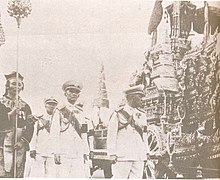
The Royal Thai Aide-De-Camp Department is a royal service agency under theRoyal Security Command.It is responsible for organizing royal appearances and maintaining the safety of theThai royal family.Royal Thai aides-de-camp are also appointed to senior officers of the ThaiArmy,Navy,andAir Force.King Chulalongkorninitiated the Royal Guard in 1870, during his visit to Singapore and Indonesia. He had a lieutenant general who served as his aide, who was considered the first Thai aide-de-camp.[31]
United States
[edit]

Military officers are assigned as aides to thesecretary of the Army,secretary of Defense,vice president,andpresident of the United States.For government officials with more than one aide, the senior-ranking aide usually coordinates the activities of the other aides as well as personal attendants such as drivers ororderlies.[33]
The president has six military aides, one from each of the armed services. The president's aides from the Army, Marine Corps, Air Force and Space Force aremajorsorlieutenant colonels,and the aides from the Navy and Coast Guard arelieutenant commandersorcommanders.One of their major roles is to hold the presidentialnuclear football.In addition to the six permanent aides-de-camp, there are some 40–45military social aidesholding more junior ranks fromlieutenantto major. Their appointment is temporary and part-time, serving for perhaps two to four afternoons a month as required, for social purposes such as gatherings hosted at theWhite House.[34]
In theUnited States Army,aides-de-camp are specifically appointed togeneral-grade officers (NATO CodeOF-6throughOF-10). The usual tour of duty for aides is up to two years.[citation needed]Although Congress has authorized general officers to be assigned up to three officer aides, their number and rank being contingent upon the general's grade, Army regulations have traditionally limited each general to a single officer aide.[34][33]Some generals are also authorized to have enlisted aides on their staff.[35]A general, based on his or her grade, may choose for an aide-de-camp any commissioned officer up to the following maximum rank:[34]
- Brigadier general:first lieutenant
- Major general:captain
- Lieutenant general:major
- General:lieutenant colonel
- Chief of staff, U.S. Army:lieutenant colonel, and four authorized enlisted aides[36]
- General of the army:lieutenant colonel, and three authorized enlisted aides[33]
Lieutenant colonels and colonels in command of units (battalions and brigades, respectively) do not have aides. Occasionally, the unit'sadjutant(S1) will assist the commanding officer as an aide, but this is uncommon. A general of the army does not retire and remains an officer of the United States Army for life,[37]and is entitled to an aide.
U.S. Armyaides-de-camp wear a special device in place of thebranch-of-serviceinsignia, representing their affiliation with infantry, artillery, or quartermaster, that they would otherwise wear on the lapels of their service uniform. The rank of the general officer being served is indicated on the device worn by the aide-de-camp, as illustrated below. Although the chief of staff of the Army and the chairman of the Joint Chiefs of Staff are O-10 positions, their aides-de-camp wear devices specific to those offices, rather than the normal four-star aide device. Also, an aide-de-camp wears a specialaiguilletteon the shoulder of his or her dress uniform.
-
Insignia for an aide to a brigadier general
-
Insignia for an aide to a major general
-
Insignia for an aide to a lieutenant general
-
Insignia for an aide to a general
-
Insignia for an aide to ageneral of the army(the most recent general of the army retired from active service in 1953)
-
Insignia for an aide to the vice chief of staff of the army
-
Insignia for an aide to the chief of staff of the army
-
Insignia for an aide to the under secretary of the army
-
Insignia for an aide to the secretary of the army
-
Insignia for an aide to the vice chief of the National Guard Bureau
-
Insignia for an aide to the chief of the National Guard Bureau
-
Insignia for an aide to the vice chairman of the Joint Chiefs of Staff
-
Insignia for an aide to the chairman of the Joint Chiefs of Staff
-
Insignia for an aide to the secretary of Defense
-
Insignia for an aide to the vice president of the United States
-
Insignia for an aide to the president of the United States
In the U.S. Navy, the aide-de-camp to anadmiralis also known as a "flag aide" (command ashore) or "flag lieutenant" (command afloat).[38][39]
The highest honor of the U.S. state ofTennesseeis "Colonel Aide de Camp". These colonels serve as the personal aides-de-camp to thegovernor of Tennessee,and their appointments are recorded by theSecretary of State of Tennesseewith those who have been commissioned into the State Guard andTennessee National Guard.[40]
Variations
[edit]- Aide-de-camp general
- Aide-de-camp to the emperor of Japan
- Air aide-de-camp
- First and principal naval aide-de-camp
- Flag aide-de-camp
- General's enlisted aide
See also
[edit]- Adjutant,a military appointment who assists the commanding officer with unit administration
- Attaché,a similar role in diplomacy
- Batman,a similar role for lesser officers
- Body man,for modern politicians
- Equerry,an attendant who historically held responsibilities for the horses of an officer
- Bernard Schriever,a former aide-de-camp and pilot who was a founder of theUnited States Space Force
Notes
[edit]- ^Jones, Daniel(2003) [1917]. Roach, Peter; Hartmann, James; Setter, Jane (eds.).English Pronouncing Dictionary.Cambridge:Cambridge University Press.ISBN3-12-539683-2.
- ^abcChisholm, Hugh,ed. (1911)..Encyclopædia Britannica.Vol. 1 (11th ed.). Cambridge University Press. p. 435.
- ^Belgian Monarchy website, Royal Household, Military Household
- ^abCanada Gazette,9 February 1974.
- ^abCanadian Forces Administrative Order 3–4.
- ^abcCanadian Forces Publication 265.
- ^"Styles of address – Others".Canadian Heritage.13 December 2013.
- ^"Staff Pay Tribute to Late Sir Michael Ogio".Post Courier.Papua New Guinea.
- ^"103 honorary aides-de-camp appointed".Channel NewsAsia. Archived fromthe originalon 8 June 2013.Retrieved24 May2013.
- ^"Sri Lanka Army Officers Service Regulations"(PDF).
- ^"High-level Sri Lankan Defence delegation attends International Military Technical Forum" ARMY-2019 ", meets top Russian Defence officials".srilankaembassy.ru.July 2019.Retrieved25 May2021.
- ^"Gen. Denzil Kobbekaduwa, who led from the front".Sunday Observer.Sri Lanka. 5 August 2007.Archivedfrom the original on 6 December 2014.
- ^"Suicide Terrorism: A Global Threat".Jane's Intelligence Review.20 October 2000. Archived fromthe originalon 20 August 2001.
- ^Bloom, Mia (24 May 2009)."What the Tigers Taught Al-Qaeda".The Washington Post.
- ^"Fonseka still critical after suicide bomb attack".Tamil Guardian.Retrieved29 March2015.
- ^"If This Is Called Peace".Time.Archived fromthe originalon 14 February 2007.Retrieved30 April2006.
- ^abcdefEncyclopaedia Britannica(9th ed.). Edinburgh: Adam and Charles Black. 1875. p. 425.
- ^American Revisions and Additions to the Encyclopaedia Britannica.Chicago: The Werner Company. 1893.
- ^James, Charles (1816).An Universal Military Dictionary, in English and French(4th ed.). London: T. Egerton. p. 8.
- ^abcArmy Dress Regulations 2017, Part 10.
- ^London Gazette,various editions.
- ^abcAllison, Ronald; Riddell, Sarah (1991).The Royal Encyclopedia.London: Macmillan Press. p. 7.ISBN0-333-53810-2.
- ^Naval Dress Regulations, 2018.
- ^Uniform, dress and appearance regulations for the RAF, 2004.
- ^Vrangelʹ, Petr Nikolaevich, Baron(1929).The memoirs of General Wrangel, the last commander-in-chief of the Russian national army.Translated by Goulston, Sophie. London:Williams & Norgate.Retrieved16 July2022.
{{cite book}}:CS1 maint: multiple names: authors list (link) - ^Regulation of the Minister of the State Secretariat of The Republic Of Indonesia Number 12 Year 2016 Concerning Instructions for the Implementation of the Administration of The President/Vice President and spouses
- ^"Pemeriksaan Psikologi Calon ADC Presiden RI Beserta Ibu, dan Calon ADC Wakil Presiden RI Beserta Ibu"(in Indonesian). Indonesian National Armed Forces. 2014.Retrieved28 August2021.
- ^"What/Who is an ADC?".President of Ireland.Retrieved3 June2020.
- ^abLeal, Tenente-general José Manuel Santos Faria."A Casa Militar da Presidência da República".Revista Militar.Retrieved8 June2021.
- ^Portuguesa, Presidência da República."Serviços de Apoio".presidencia.pt(in Portuguese).Retrieved8 June2021.
- ^"สำรวจโครงสร้าง" ราชการในพระองค์ "ก่อนปรับโครงสร้างใหม่"[Structure of His Majesty's Civil Service Before Prospective Changes].BBC(in Thai). 20 April 2017.Retrieved17 October2019.
- ^Terrance Bell, U.S. Army Garrison Fort Lee Public Affairs(06.16.2020) BG Michelle Letcher is 42nd Chief of OrdnanceBrigadier General date 2 Mar 2020.
- ^abcU.S. Army Quartermaster Center and School (July 2010)."Enlisted Aide Training Course"(PDF).Fort Lee, Virginia: Army Center of Excellence, Subsistence. p. 34.Archived(PDF)from the original on 11 February 2017.
- ^abc"Army Regulation 614-100: Officer Assignment Policies, Details, and Transfers"(PDF).Assignments, Details and Transfers.U.S. Department of the Army. 10 January 2006. pp. 8–9. Archived fromthe original(PDF)on 25 February 2013.Retrieved12 June2019.
- ^General Officer Management Office (August 2010)."Officer/Enlisted Aide Handbook"(PDF).U.S. Department of the Army.Archived(PDF)from the original on 22 June 2017.
- ^"Army Regulation 614-200: Enlisted Assignments and Utilization Management"(PDF).Assignments, Details and Transfers.U.S. Department of the Army. 29 November 2017. p. 76, para. 8–11a.Archived(PDF)from the original on 26 January 2019.
- ^Grant Harward (2018) William Beaumont Army Medical Center
- Alden Whitman (9 April 1981)"Gen. Omar N. Bradley Dead at 88; Last of Army's Five-Star Generals".New York Times.
- ^Staff (27 February 2020)."Mathis appointed Colonel Aide de Camp".The Newport Plain Talk.Retrieved16 April2020.
Further reading
[edit]- Lawrence P. Crocker (September 1996).Army Officer's Guide.Stackpole Books.ISBN978-0-8117-2665-8.
- Australian Army Protocol Manual 1999.Defence Publishing Service DPS: 31568/99.
External links
[edit] The dictionary definition ofaide-de-campat Wiktionary
The dictionary definition ofaide-de-campat Wiktionary

















